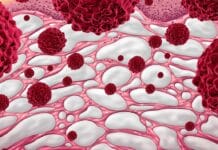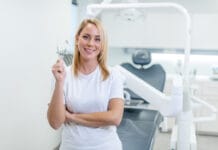“If it’s on the internet, it must be true.” This phrase has jokingly been thrown around probably since the invention of the internet. This modern convenience has allowed so much information to be accessed and easily disseminated; however, it is important to fact-check online content. Unfortunately for dental workers (and health care in general), a quick Google search often makes patients feel like an expert on dentistry before they even step foot into the office to be assessed or diagnosed.
Throughout my experience as a dental professional, I have heard several lies that Google has taught my patients.
Gain a Child, Lose a Tooth
The first dental lie that Google has taught my patients is the concept of “gain a child, lose a tooth.” We’ve all heard our momma patients make the claim that pregnancy ruined their teeth. In fact, they usually cite blogs or articles from other mothers who claim that the baby sucked the calcium right out of their teeth.
While pregnancy can affect the mouth in many ways, depletion of calcium isn’t one of them. The growing baby gets calcium from the mother’s diet, not from her teeth.
Explaining the factual ways that pregnancy affects teeth can help debunk this theory. Providing education on how hormonal and immune response changes can cause pregnancy gingivitis, how morning sickness and brushing immediately afterward can cause acid erosion, and how dry mouth can put the teeth at a greater risk for caries can help maintain patients’ oral health during pregnancy.
The Miracle of Healing
A close second among the dental lies found on the internet is that cavities can be healed naturally without being filled. While this concept may seem like an amazing way to put the dental profession out of business, it simply isn’t true.
The first response Google gives for healing cavities naturally is a list of things ranging from oil pulling to aloe vera and vitamin D. Some things such as oil pulling can be a good additive to an already great oral care routine, but there is no research that supports it as a cavity healer.
We all learned about the phases of carious lesions in school, and we know that there is a small window of time where an early lesion can be remineralized. According to the American Association of Dental Consultants, incipient lesions can be difficult to diagnose, but removing tooth structure for early treatment isn’t always the correct solution. Applying fluoride or casein phosphopeptide (CPP) is a viable solution for remineralization of an incipient lesion.1
Explaining the different phases of carious lesions and when drilling and filling are necessary can help settle the confusion of healing cavities.
It’s in the Genes, Son
One of my favorite dental lies my patients have been taught is that “bad teeth run in my family.” If we’ve heard it once, we’ve heard it a hundred times. Patients often use this as an excuse as to why they don’t brush or floss as they should.
“If my parents got dentures at 30, that must mean that my teeth won’t hold up for my whole life either. So why should I waste my time taking care of them?”
I cringe every time I hear this line of reasoning. It’s very difficult to explain why this is the wrong way of looking at it. There are oral conditions that run in the family, such as enamel hypoplasia. For the most part, though, oral health conditions are environmental.
Many debates have been made about the heredity of dental caries. Some claim that cavities are genetic while others cite environmental causes. According to the American Dental Association, plaque and cavity-causing microbiomes can be genetic. How the patient responds to them, though, is what determines the level of caries.2 In other words, a patient may present with a greater volume of bacteria in the mouth that contribute to caries, but if the patient’s diet and home care are good, they’re at no greater risk.
The Persistent Lies About Flossing
The next dental lie is a toss-up between “flossing makes my gums bleed” and “flossing isn’t necessary.” Since they’re both similar in nature, let’s discuss them together.
I once had a patient question me on why I was flossing her teeth because she claimed that Dr. Oz said it actually wedges food or plaque further into your gums and causes bleeding and damage. (Maybe I’ve been living under a rock, but I could not find where Dr. Oz allegedly made that statement.) Regardless of whether that statement was made on his show or not, it’s not true that flossing does more harm than good. Flossing is only effective up to a certain depth, which means that if floss can’t reach those 9-millimeter pockets, it certainly can’t shove food and plaque particles into the deep abyss of the oral cavity.
Explaining the body’s immune response to plaque can help clear the water on why gums bleed that haven’t been properly maintained. Flossing (aka cleaning interdentally) prevents bleeding gums, but it doesn’t cause it in healthy tissue.
If it Doesn’t Hurt…
The last dental lie my patients have been taught is that routine dental exams and cleanings aren’t necessary. Dental appointments may not be viewed as a pleasant experience for all patients, but it does play a key role in the prevention of oral disease and tooth loss.
The “if it ain’t broke, don’t fix it” mentality has caused an abundance of dental problems for some of my patients. When cavities or some form of periodontal disease has been detected, the first thing my patients say is that they haven’t experienced any symptoms. This is a big reason why patients put off routine exams. If nothing hurts, it must be OK.
The internet provides many articles that support the claim that it isn’t necessary to go to the dentist routinely. While some tooth loss and decay can’t be prevented by regular exams and cleanings, it can prevent the damage from being as great as it could’ve been.
The internet is a wonderful place to find answers to many questions. It can give great insight to issues that our patients are curious about. However, fact-checking and educating in the operatory are important ways to debunk the dental lies our patients have been taught by unreliable sources.
Before you leave, check out the Today’s RDH self-study CE courses. All courses are peer-reviewed and non-sponsored to focus solely on pure education. Click here now.
Listen to the Today’s RDH Dental Hygiene Podcast Below:
References
- Fitzgerald, D.E., Pesillo, C. (2017). Early carious lesions–treatment considerations. The American Association of Dental Consultants. Retrieved from https://www.aadc.org/articles/articlespositionstatements/aadc-position-statemtent-early-carious-lesions-treatment-considerations_120000.aspx
- American Dental Association. (2019). Genetics and oral health. Retrieved from https://www.ada.org/en/member-center/oral-health-topics/genetics-and-oral-health












